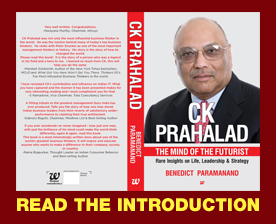 Sanjiv Sarin, Regional President – South Asia, Tata Global Beverages, reflects on how what he learnt at the Art of Living helped him in dealing with an underperforming executive
Sanjiv Sarin, Regional President – South Asia, Tata Global Beverages, reflects on how what he learnt at the Art of Living helped him in dealing with an underperforming executive
The corporate world is essentially an intricate place where everyone is affected and dependant on each other. The unimpeded weak employee performance in an organization has repercussions on business results, on colleagues and your leadership. Yet it is often tough to tap the issue with sensibility as such issues have to be confronted, and very often the fear of one-sided win can engulf.
As a leader we can rely strictly on facts and act accordingly or be caring and considerate. Either ways, the results are very divergent. Business and leadership deals with numbers but the actions we take impact beyond numbers because people on the other end perceive how they will be treated. This perception, to my mind, is one of the key determinants of their level of engagement with the organization. Therefore, high engagement creates high belongingness, and vice versa.
There was a situation many years ago involving a very senior employee. Under him the business had been in a state of steady decline. The business required new direction to bring it to profitable growth but the incumbent was unable to do so. Clearly, there was a need for change at the helm. And it was urgent. The quick and simple route would have been to terminate his/her employment.
But questions came up in my mind – What is my role as a leader? Have I gone behind the symptoms? Am I doing right? Am I aware of the consequences of my decisions on the person? Yet, there was a reality check to be made on managing performance, establishing standards in the company of dealing with poor performance. How do I assess the intensity and correctness of the action that needs to be taken? How do I gauge that the action implied is an assured way to boost up the performance?
During this period I came upon an insight that has stood by me – if a decision is for the greater good of the organization then it is right. Depending on my insight, I tested this option of the change required and in my mind it passed.
It was important that I also do justice to the person. This acceptance, so ingrained in me by H.H. Sri Sri Ravishankar and the Art of Living programs, brought the mind into a state of calm exploration. It pushed me to a wide scan of information, spoken and unspoken, without consciously pre-judging. A bias, colors perception and it filters what we look for or how we interpret what we see.
The clear lens made me see that the person was sincere and very hard working. He had invested a lot of time and energy into the business. He had unselfishly let himself be parachuted into the larger role to help the organization. I realized his strengths were in areas that this business needed at a particular stage of its evolution. In the current phase the fit was low. Had we invested in building the required capabilities? No, we had not.
I had multiple dialogues with the leadership team at the Group level and got them aligned about the need for change. The HR head asked me to go ahead with the change and leave the relocation to him.
This did not feel right. As a line manager I had the responsibility to influence rehabilitation. How else would I be doing the right thing for the employee? Then came the issue of speaking with the employee – my first chat was brief and to the point – there was a need for change. I put myself in his position and said how would I feel in such a position, would I be devastated? Would I not want to know more? Was I being callous?
This lead to a dialogue between us about the business from the time he came in, to where it was now and what it required at this stage. We spoke about what capabilities he brought and what were the weaknesses. The deep level of homework I had done helped clear expression of the issues. The fact that I was engaging him, listening to him, responding to him, not finger pointing created an environment of trust which enabled him to understand and acknowledge the issues. His self-worth was intact, while he realized he had underperformed in the current role. We dialogued a smooth transition. I grew because of the quality of interaction and end result.
The message to the organization was also clear – we will do what is right for the business and also do right to the person in question. To me the acid test was that we could both look comfortably into each other’s eyes knowing I had done the right thing to him and to the organization. The creation of a winwin situation. What did I learn? • Managing performance is very important but managing the person behind the performance is even more important. You can be callous or considerate.
There are choices and consequences of the choices follow the same.
- More often than not people are working at doing their best. Do not doubt their commitment.
- Listen, digest, dialogue. Do not prejudge. There is no substitute to this.
- Sensitize yourself and scan for information, expressed and unexpressed, without bias.
- We are a party in creating the people we groom. If we provide an enabling environment and give people the respect, it creates belongingness, again induced in life by the Art of Living Apex program. Belongingness creates serious commitment to the organization.
- Be trustworthy, transparent and sensitive. If you are, you open yourself to positive responses and outcome.
- Be human and principled.
- Be in a state of calmness because that gives clarity of purpose and allows you to take the right path.
I believe we are here to make a difference in people’s lives and support them in their journey to blossom. In their growth, we grow. And basic human values in interaction enable that.











Recent Comments